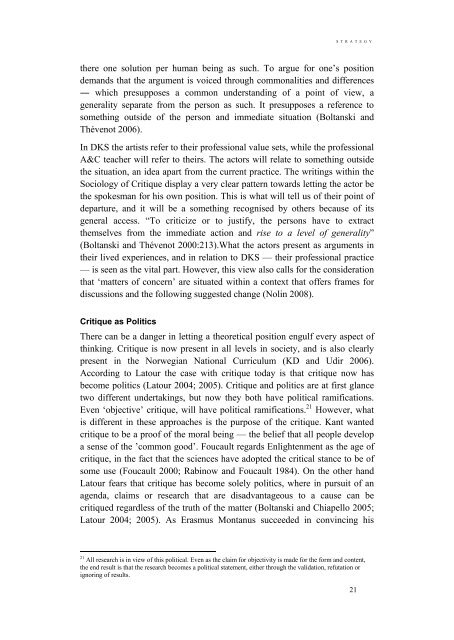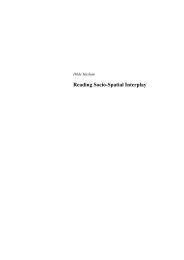CON ⢠TEXT - Arkitektur- og designhøgskolen i Oslo - AHO
CON ⢠TEXT - Arkitektur- og designhøgskolen i Oslo - AHO
CON ⢠TEXT - Arkitektur- og designhøgskolen i Oslo - AHO
- No tags were found...
Create successful ePaper yourself
Turn your PDF publications into a flip-book with our unique Google optimized e-Paper software.
S T R A T E G Ythere one solution per human being as such. To argue for one’s positiondemands that the argument is voiced through commonalities and differences― which presupposes a common understanding of a point of view, agenerality separate from the person as such. It presupposes a reference tosomething outside of the person and immediate situation (Boltanski andThévenot 2006).In DKS the artists refer to their professional value sets, while the professionalA&C teacher will refer to theirs. The actors will relate to something outsidethe situation, an idea apart from the current practice. The writings within theSociol<strong>og</strong>y of Critique display a very clear pattern towards letting the actor bethe spokesman for his own position. This is what will tell us of their point ofdeparture, and it will be a something rec<strong>og</strong>nised by others because of itsgeneral access. “To criticize or to justify, the persons have to extractthemselves from the immediate action and rise to a level of generality”(Boltanski and Thévenot 2000:213).What the actors present as arguments intheir lived experiences, and in relation to DKS — their professional practice— is seen as the vital part. However, this view also calls for the considerationthat ‘matters of concern’ are situated within a context that offers frames fordiscussions and the following suggested change (Nolin 2008).Critique as PoliticsThere can be a danger in letting a theoretical position engulf every aspect ofthinking. Critique is now present in all levels in society, and is also clearlypresent in the Norwegian National Curriculum (KD and Udir 2006).According to Latour the case with critique today is that critique now hasbecome politics (Latour 2004; 2005). Critique and politics are at first glancetwo different undertakings, but now they both have political ramifications.Even ‘objective’ critique, will have political ramifications. 21 However, whatis different in these approaches is the purpose of the critique. Kant wantedcritique to be a proof of the moral being — the belief that all people developa sense of the ’common good’. Foucault regards Enlightenment as the age ofcritique, in the fact that the sciences have adopted the critical stance to be ofsome use (Foucault 2000; Rabinow and Foucault 1984). On the other handLatour fears that critique has become solely politics, where in pursuit of anagenda, claims or research that are disadvantageous to a cause can becritiqued regardless of the truth of the matter (Boltanski and Chiapello 2005;Latour 2004; 2005). As Erasmus Montanus succeeded in convincing his21 All research is in view of this political. Even as the claim for objectivity is made for the form and content,the end result is that the research becomes a political statement, either through the validation, refutation orignoring of results.21
















